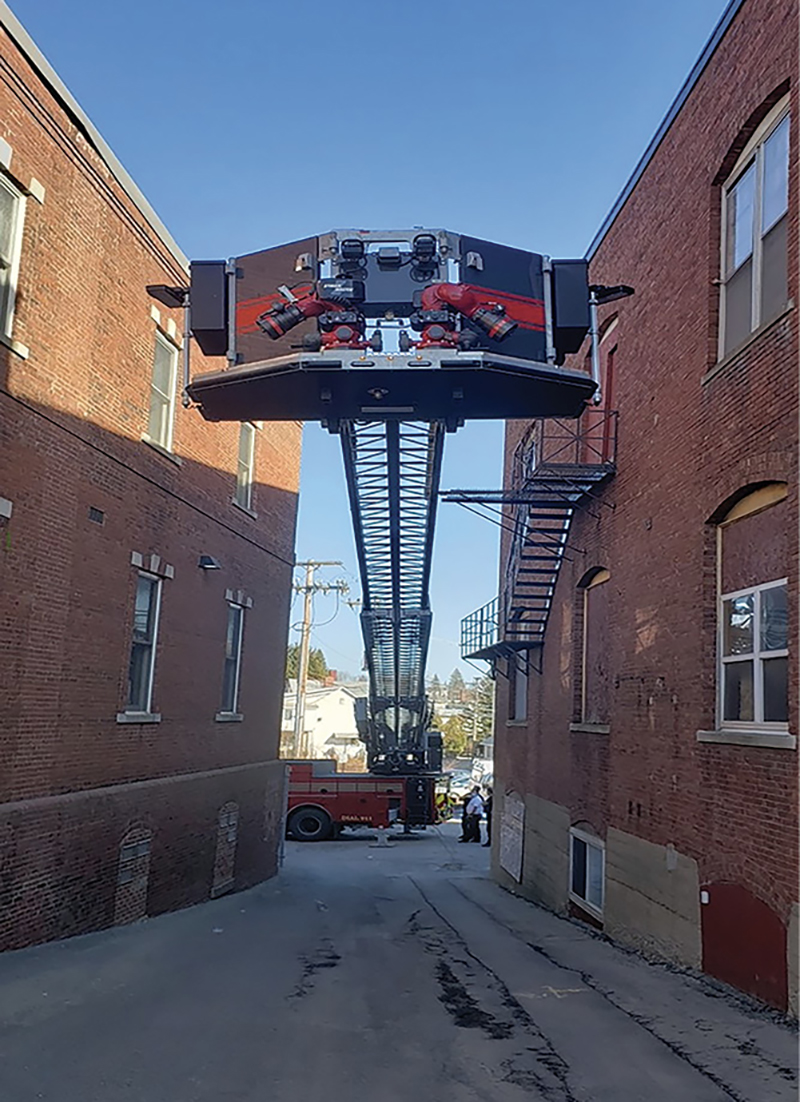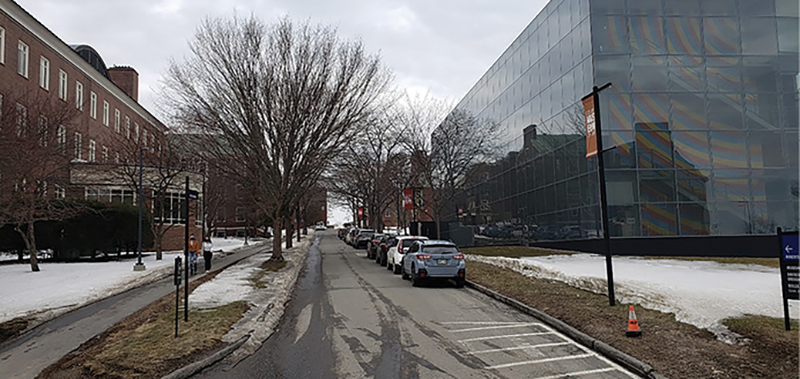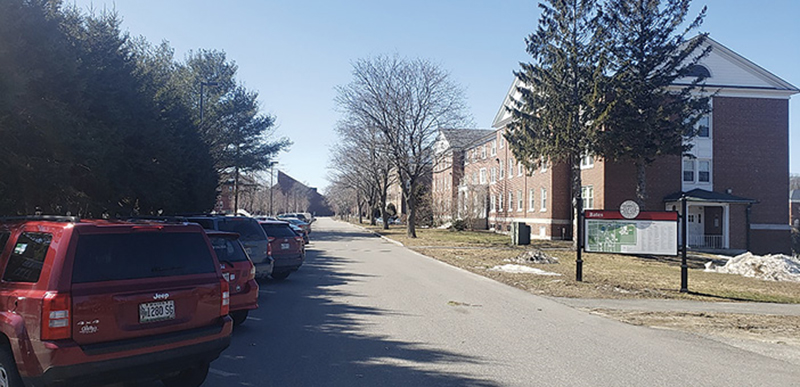By RYAN JOHNSTON
Scenario: the last place you might think about positioning your aerial is on a college campus; you pull the aerial in, find a place to “park,” and wait for the incident commander (IC) to clear you so you can go back to the station. Ask yourself, do you look at the actual building to where you’re going, or do you find the easiest area to turn around that monster truck? Do you know which obstacles you might face on any of the campus buildings? Better yet, what hazards are around or in them? This article will shed some light on the complexity and possible issues to look for and mitigate before you respond for the real deal.
Dorms
Dorms are likely one of the larger occupied structures in your response area. If yours are like ours, they have two, three, or four floors with about 25-plus rooms per floor and anywhere from two to four students living in each room. Also think about the students’ “occasional guests.” So, an accurate number of students in a particular dorm is not something you will have early on in an actual event/fire. You also must consider how accurate that count will or will not be. Because of these aforementioned “guests” or because the alarm is going off for what seems like the 11th time that night, it is not being taken seriously. In any case, your number-one priority—life safety—is going to be a challenge before you even consider where you will place your aerial.
- The Do’s and Don’ts of Positioning Aerial Apparatus on the Fireground
- Aerial Apparatus Stabilization: It Starts from the Ground Up
- Positioning Aerial Apparatus When You’re Not First Due
Other challenges presented are the roof types. In my area, one of the dorms has multiple roof levels and two different roof types. The first is a flat roof, some with a parapet wall at the top of the second floor. This one-story section houses the dining area along with a full kitchen capable of feeding hundreds of students and staff. Attached are the dorms, which are three or four stories. Students can access this flat roof from their rooms.
The second roof type is a pitched roof with limited access for an aerial. You have options for rescues from this pitched roof to the dorms on that side by ground ladders. Access to the flat roof is limited as well.
Most of the dorms in our area are sprinklered. However, because of construction or some other activity, these systems have been tampered with; thus, in a fire, the possibility of trapped occupants increases, which also increases the need to look at these flat roofs, balconies, and fire escapes for victims.
Some colleges allow students to live in houses on or next to campus. Many of these houses may be a fraternity house or just apartment-style housing. Regardless, these places are usually older homes bought by the college and renovated, usually multiple times. These buildings are built to house a certain number of students but, as previously mentioned, this number will rarely be accurate because of multiple scenarios.
Some dorms are set up with a courtyard on one side, similar to garden-style apartments. These can be particularly hazardous if they are larger in size and, depending on their distance from the road or the parking lot, you may not get the aerial to them. If you are fortunate enough to get a good set, you may need the roof officer to finish your 360° size-up from the roof until you can get eyes in the rear (courtyard).
What Is Your Typical Response?
What type of calls are you responding to? What is your response protocol? Do you go on every alarm, or is security going first to “check it out”? Some colleges send only security to check an alarm to see if it is “real” or not. The fire department responds only to water flow alarms or actual 911 calls from the building.
On occasion, there are issues with parties and events where the alarms may get set off several times in a night. At that point, reduce the response to a single engine to that area for the evening or post someone on site from either the fire department or security. Remember, their safety is not just our concern but also our responsibility, not how much time we miss from our bunks or the cost of sending our apparatus there. There are plenty of avenues to assist with and curb the nuisance issues.
When you preplan these buildings, bring your apparatus on campus and see what will fit or will not fit and where. Perhaps it’s just a simple change in your response order. Send the truck in first vs. an engine or let the first-due officer/chief go with the chief’s car, get a look at the situation, and decide from there.

(1) The dorms at our local college feature many tight alleys and spaces, and we need to be proficient in maneuvering the aerial in these spaces. Here, crews train on “shooting” an alley and moving the aerial in tight spaces with obstacles from the bucket and turntable. (Photos by author.)
Road Access or Lack Thereof
Once upon a time, a college campus had roadways or even large pathways that were capable of handling vehicle traffic. The intent was to allow for service vehicles and the ease of moving students into and out of their dorms. These paved roadways were easily accessible for fire apparatus. Now, these formerly paved roadways are no longer there and, if they are, they are barely wide enough to fit a golf cart. The areas are now all green spaces or grass or have planted trees, shrubs, and mulch beds. This does not bode well for if or when you need to make the set with your aerial. This article is primarily about aerial ops, and you may think it is just as tough for the engine company, but the engine’s one advantage is that it can extend its hoselines. Our aerial length only goes as far as it goes; you cannot add to it or stretch an extra inch out of it.
Yes, it takes time to extend lines, which is why you must preplan these buildings and have that 300- or 400-foot hoseline ready to go. It can be useful elsewhere as well. The roadways that do exist, in my experience, are usually toward the rear of the buildings. This is likely the access for food services or maintenance, and it maybe your only shot at easy access around the building or to the roof, if you need it. Now, in a perfect world, this access point would be free of obstacles, but more likely there will be cars, service vehicles, snowbanks, dumpsters, broken furniture, and a dozen other items you will have to work around or move. Preplan your access so you know immediately if you need to back in or drive straight in.
In my research for this article and during walk-throughs of our campus, I was told that the future of campus travel is vehicle free, meaning less roadways and more walkways, which narrows our shot at a good set and which, in turn, means we’ll most likely be unable to use the aerial. Thus, our ground ladder operations should be well-tuned for operations on campus.
Topography and Obstacles
If your college campus is anything like ours, there are a bunch of rules or ordinances that the college or town/city adds to make the campus “shine.” Some are there to make sure there is an abundance of green space, others to make sure there are a certain number of trees. Some even state that there must be a tree at a certain number of feet between the road and the building, specifying the species and size.
You also have objects like art pieces that are likely placed in what would be the optimal spot for an aerial. (You know that one spot where you can get two sides and the roof? Well, not today!) Now that spot is taken by an expensive piece of art that, by the way, you also need to protect.
Part of the issue here is lack of access to these buildings—not only the office buildings, science buildings, museums, and chapels but their residential buildings, dorms, and apartments (the places where the most important assets lay their heads). And it’s not just about a lack of access for the aerial but overall lack of access. Take the setbacks, trees, and other obstacles into consideration; add the unknown number of students in one dorm; and this could be a recipe for disaster. This doesn’t even consider the living conditions inside. Let’s just say that, if you have ever been in college dorms, you understand how clean and neat (or not) they are.

(2) The Colby College campus. The old road between the science buildings and the museum, with limited access to the science buildings on the left-hand side.

(3) Colby College’s new walkway, where the road used to be (between the science buildings and museum). A green space will be created to the left of the construction fence, leaving minimal room for the aerial to set along with added obstructions of trees and shrubs.
Some dorms have a large parking lot next to them, although this may not be true for long. These lots are likely full of cars blocking access for the aerial, or there may be winter conditions that do not allow them to be plowed. Some students rarely drive, so their vehicle is “snowed in.” Another issue you may face is gaining access to the lot itself. Is it protected by a gate? Is there a gate, and do you have a fob or key to gain access? Will you have to force the gate?
Another problem you may face is having access to just one side of a building, and that side could be filled with obstacles. Then, the only other way to the other side of the building is a four-foot-wide walking path. If you are lucky, that path is made of concrete, and you may be able to ease your way out there, pending any other obstacles. All these factors and more weigh in on your response and placement decisions. Other obstacles you must look out for are dumpsters, utility poles, wires, transformers (ground), confined spaces, vaults, steam pipe chases, farm-type buildings, and livestock.
On a normal response to your typical wood-frame residential, your thoughts of obstacles range from wires to mailboxes, street signs, shrubs, and so on. On college campuses, it is the unknown obstacles that really challenge your skills. Typically, you see a manhole cover and think “sewer” or “electrical” and have some type of idea what direction they travel because of the other types of covers. Some campuses heat their buildings with steam, which requires pipe chases. The only way to know where these are is to look for the covers to the vaults and have a plan or drawing on their direction of travel. This obstacle will come into play when you potentially have to “beach” (drive off-road onto the lawn, dirt, or earth) the aerial. The steam chase in photo 5 shows the steam chase cover, which is between the street and sidewalk on the building side. This is likely not a good spot for an outrigger/ground jack. So, get out to your local campus and train on the locations of these and other obstacles.
Sometimes, when you make the set on “soft” earth, the ground pads may not be enough or there may be some uneven ground with which you have to contend. Carrying cribbing along with some wedges and even some one-inch plywood can assist you in placing the outriggers on the best solid flat ground possible for that situation. When you are in this soft ground situation, position the truck for aerial use in line with the apparatus. As you maneuver away toward the sides of the apparatus, you will place more pressure on the outriggers and onto the soft ground. This has been catastrophic for some agencies.
Where’s the Fire?
That’s always the question. Regardless of whether the fire is in a dorm; classroom; or science, maintenance, athletic, or other campus building, know your best spot for a set. Knowing or having a general location of the fire will assist you in your route and positioning to a building. Many buildings have only one legitimate spot for aerial placement. This should be well-defined in your SOG or response plan for that building. If those documents don’t exist, create them. Some preplan programs, whether done on paper or a computer, allow for predetermined apparatus positioning and assist you in hydrant locations, hazard locations in the building, alarm panels, and sprinkler rooms; you can even include known obstacles or obstructions. At the very least, get out there and see for yourself. Then, share the knowledge! Whether it is in formal training or by word of mouth, pass this information on to your previous shift or the oncoming crew. Make it a priority.
The Contents of Other Buildings
Some campus buildings hold a whole other set of concerns. Science buildings, maintenance buildings, and some athletic centers may contain hazardous materials (such as chlorine for the pool) to contend with. If your athletic center has an ice rink, you may have to deal with ammonia. A typical science building has many obstacles, from flammable gases to radioactive materials. Maintenance buildings usually have some type of heavy equipment, trucks, mowers, and more, all of which take some type of fuel to operate, thus causing some concern during your mental size-up. Have you trained on your response, and do you know where you can and cannot position your aerial?

(4) A Colby College dorm showing limited access. The road on the left is sizable enough for an aerial.

(5) A steam chase maintenance entrance.

(6) The Bates College campus. There is limited access to the dorm on the right because of the trees on the right and the vehicles on the left.
The Set
The set, like all others, starts with your size-up and any prior knowledge or experience you may have of the area of campus to which you are responding. Listening to the dispatch of the type of call/fire and where the fire may be, plan your response. This may be different for your aerial than that for the other responding apparatus. If you have that preplan or prior knowledge, then great; if not, you may be a little “behind the eight ball.” That’s okay—slow down and take in the whole scene.
Obviously, placement for life is your first concern. So, the type of building to which you are responding will dictate that life safety concern, which will change with each building depending on the time of year, the day, or any events going on (hopefully, the college has advised you of this). After you have figured out the appropriate life safety response, focus on placing the aerial and, as previous mentioned, any obstacles to overcome. Make the set and go to work. If you do not have a life safety concern, shift your focus on property and training for each of them in your preplanning. Also, become close with the appropriate people on campus and let them assist you in all aspects.
Become proactive in the college community just as you would with your town or city. Also, be proactive with your local fire code enforcement official. Most fire codes have specific provisions for apparatus access. Get involved with plan reviews of projected new campus buildings and verify the planned access. Get on the campus and learn its nuances, just as you would have when you were a probationary firefighter learning your streets and buildings. One thing I learned recently is that our local college is attempting to reduce vehicle traffic on campus, not just from the public but the students as well, who are removing roads and turning them into pathways, which reduces our access to their buildings. Yes, ground ladders still work; we all have them and need to be proficient with them. However, aerials are necessary to reach many points that ground ladders cannot. As you visit the campus in your community, you will find and be shown many hidden obstacles and concerns that you may have otherwise discovered at an inopportune time and which could prove to be costly.
Author’s note: Thanks to Colby College in Waterville, Maine, and Bates College in Lewiston, Maine, for allowing us to photograph their buildings and grounds. Also, thanks to Lewiston Fire Department Firefighter Eric Watson, who assisted me with a tour of Bates College and its streets, dorms, houses, and facilities.
RYAN JOHNSTON is a 24-year career firefighter in Maine and has also served as a volunteer for 30 years. Johnston is the rescue technician at the Waterville (ME) Fire Department and serves as a lieutenant with the Oakland (ME) Fire Department. He is also the owner of Maineiac Fire Training.

